
No Smoking in Japan
Things Change
I went to Japan on a business trip in the early 1990s.
Every day we got up early, went to the train station,
and traveled to a different city.
Tōkyō, Nagoya, and Ōsaka,
I don't think we ever stayed in the same city
for two days in a row for the whole two weeks.
It was the worst-ever solution to the
Traveling Salesman Problem.
We would drop our luggage at the hotel,
be picked up, and taken to that day's company.
We would be taken on a tour,
we would give a presentation,
and then have discussions with staff.
Then, at the end of the day,
they would take us out for dinner.
It would be the peculiarly specialized business dinner
held over from the boom years of Japan in the early
to mid 1980s.
Then, out would come the cigarettes.
People smoked like chimneys in Japan
in the early 1990s.
But not any more.
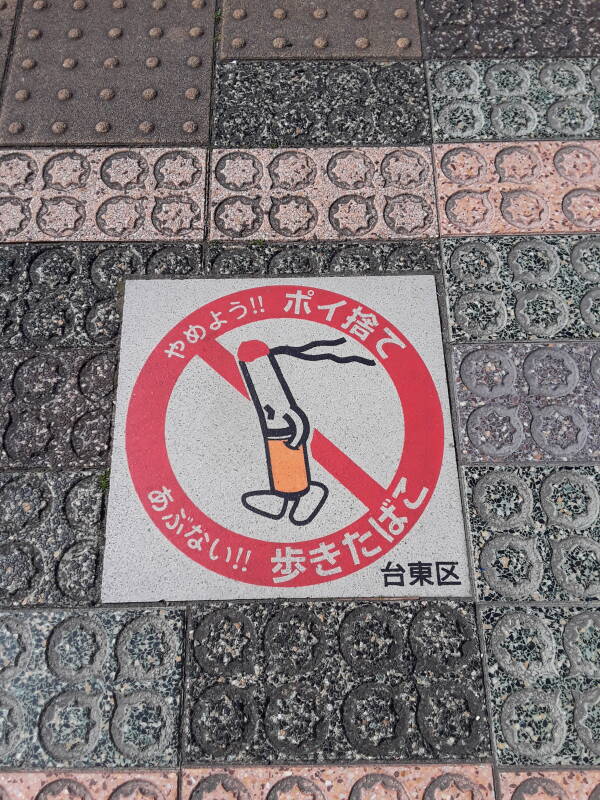
The trip, in retrospect, was rather silly. It was a technical road show attempting to find new sources of research funding for a robotics lab. But at the time no Japanese corporation or government agency had money to spare.
Japan had gone through an economic bubble from 1986 to 1991. Real estate and stock prices were vastly inflated. Then Tōkyō real estate prices began falling in 1989. The bubble burst in late 1991, beginning the Ushinawareta Jūnen or Lost Decade, economic stagnation lasting from 1991 at least through 2001. Two years after the bubble had burst, we went to Japan. Our hosts were far too polite to question what we thought we might accomplish. And, we gave them an excuse to go out for what had become a rare business dinner.
Amazon
ASIN: 0520062892
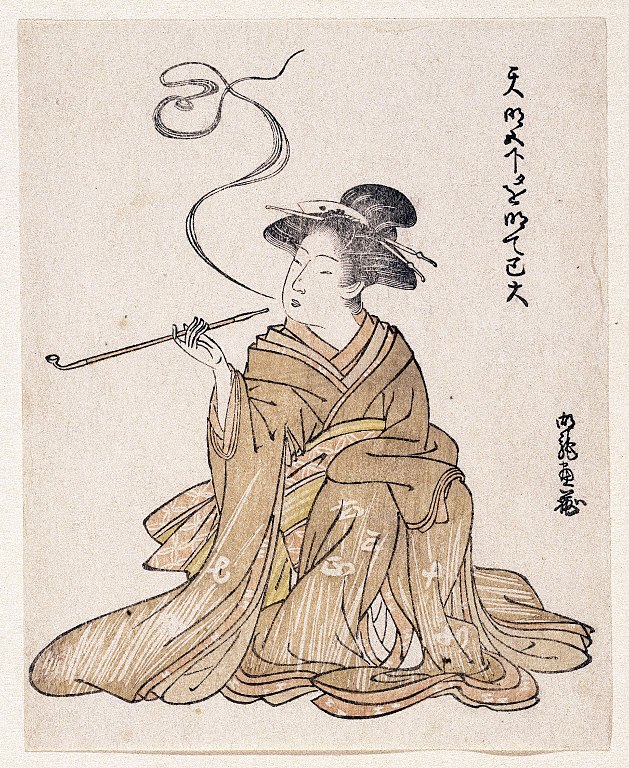
E-Goyomi (or Lady Smoking), possibly by Korinsai, 1785–1790 in the late Edo period, now in the Online Collection of the Brooklyn Museum.
The Economy Returned, and Cigarettes Largely Disappeared
Tobacco use in Japan began declining in 1996, and the rate of decline accelerated through the 2010s. By 2018 it had reached the lowest level since the Ministry of Health, Labour, and Welfare and the Japan Tobacco cigarette manufacturing company began recording smoking statistics in 1965.
Good riddance. Smoking doesn't just bother other people, it's actually quite harmful to others. Then there's all the litter, with smokers dropping cigarette butts everywhere. The butts contain "filters" which don't really do any good and are usually made of cellulose acetate fibre, a durable material that makes smokers' litter a long-lasting problem. Cigarette butts are the most littered waste item in the world. Of the appximately 5.6 trillion cigarettes smoked every year, an estimated 4.5 trillion cigarette butts become litter every year.
There are also all the medical problems and expense to the smoker. At least smoking isn't as disgusting as chewing tobacco.
The national smoking age was set at 1876, during the rule of the Meiji Emperor. The price of a particular brand and variety of cigarette is now set by the manufacturer and approved by the Ministry of Finance. It costs the same across all vendors from corner shops to large supermarkets to, of course, the ubiquitous vending machines.
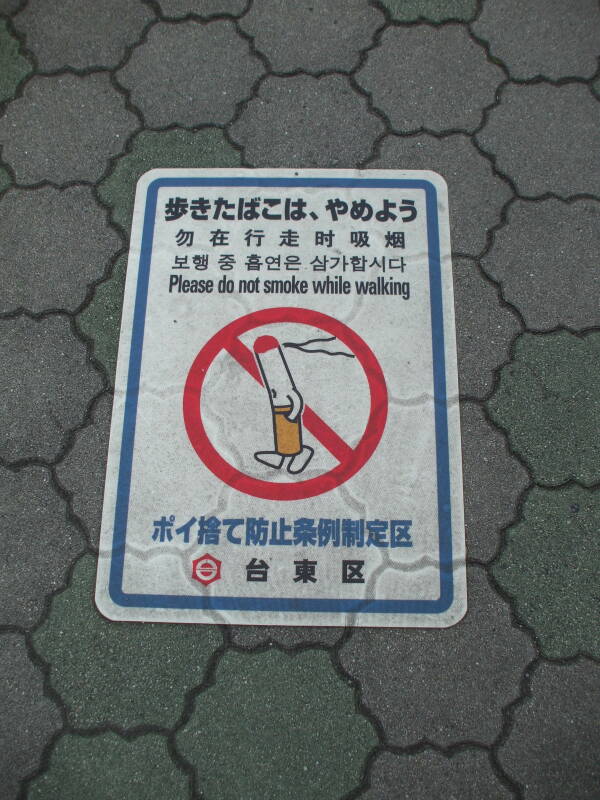
Smoking is Largely Prohibited in Public
Smoking on public streets is generally frowned upon, and many local governments have enacted laws banning smoking in public areas. This started with the Chiyoda-ku ward in Tōkyō in 2002. Here are "no smoking" signs on sidewalks in Tōkyō. They also ask you not to wander into traffic or otherwise be a nuisance by walking while fixated on your phone.
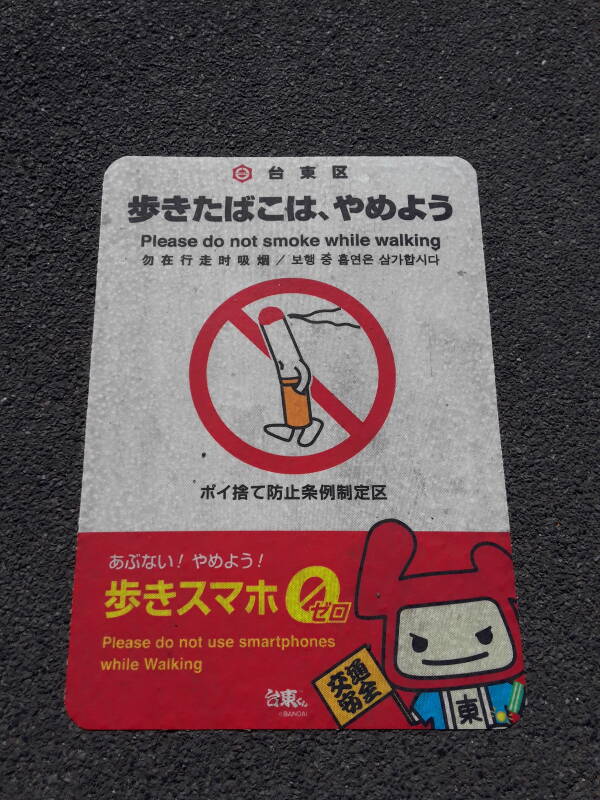
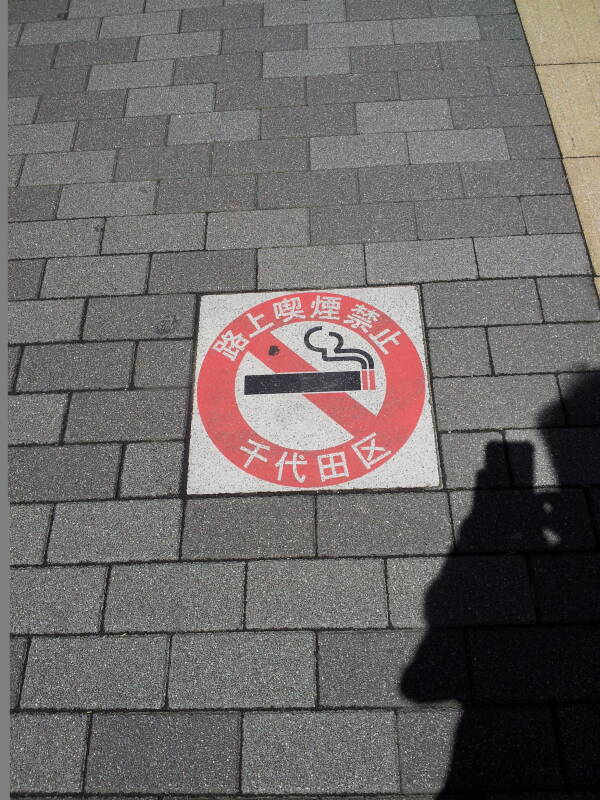
Indoor smoking is banned in schools, hospitals, and government administrative buildings throughout Japan. Businesses can have a designated smoking room, as long as minors are prohibited and no food or drink is served inside.
VisitingAsakusa
Here is a smokers' area in the Asakusa district of Tōkyō. See the people huddled next to the electrical box, largely hidden by shrubbery? That's where you have to stand in order to smoke.
The Asakusa station of the Tōkyō metro system is just beyond the smokers. Two blocks further is the Kaminarimon Gate leading to Sensō-ji, the Buddhist temple that's the second most visited religious site in the world.

Kyōto
Kyōto began designating certain city streets as non-smoking areas in 2007. By 2018 that had become all streets within a large area at the city center, plus other districts. This sign shows one such area, about 1,040 meters east–west by 770 meters north–south. It also shows three small smokers' areas along its southern edge, each marked with a purple box with a smoking cigarette.
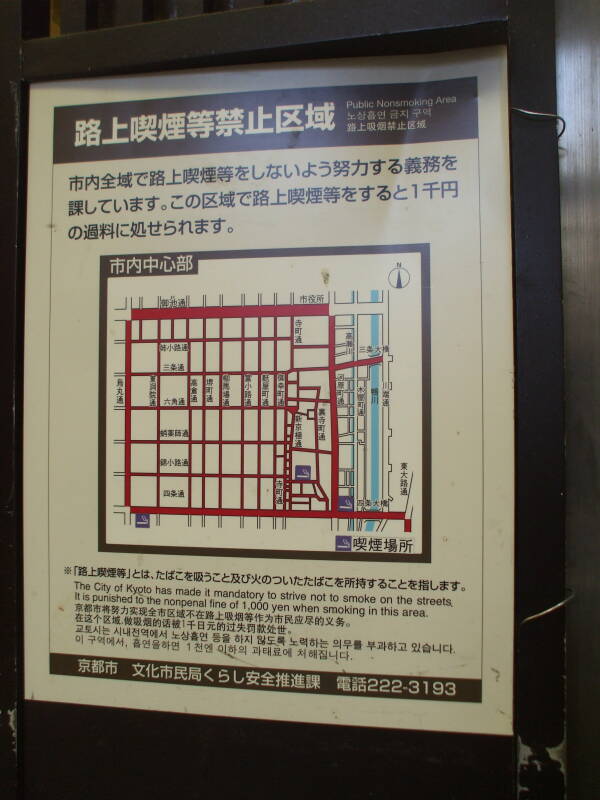
Here's one of those smokers' parks in Kyōto.
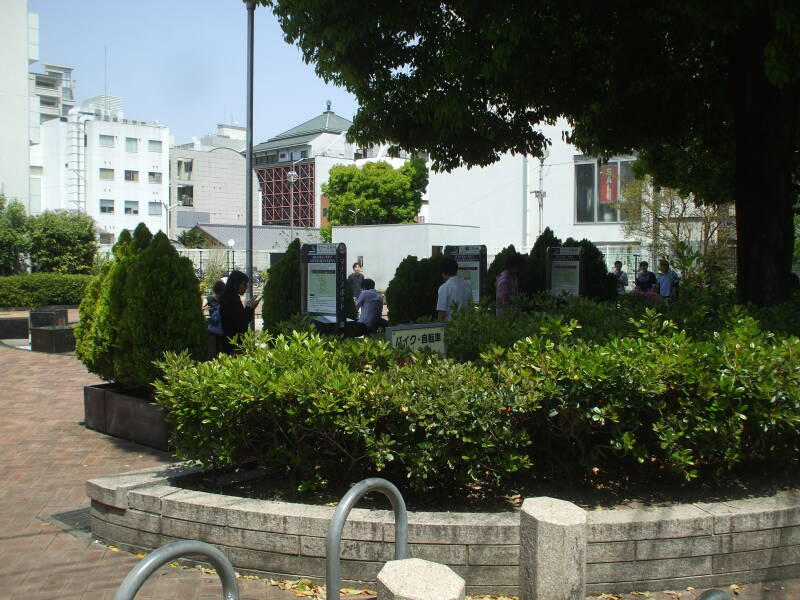
This one is in another district of Kyōto, again with most of the major street designated as non-smoking areas. There's a map of the district showing the non-smoking streets and the local smokers' parks on the waste container at the entrance.

Japan Tobacco commissioned a series of over 70 ads in the style of public-service announcements. Of course they don't want to discourage smoking! But they want to discourage behavior that makes people think that smokers are jerks.
The large cigarette waste container in the above picture holds one of their signs, reminding their addicts that they're casually carrying a dangerous object. Let's take a closer look:
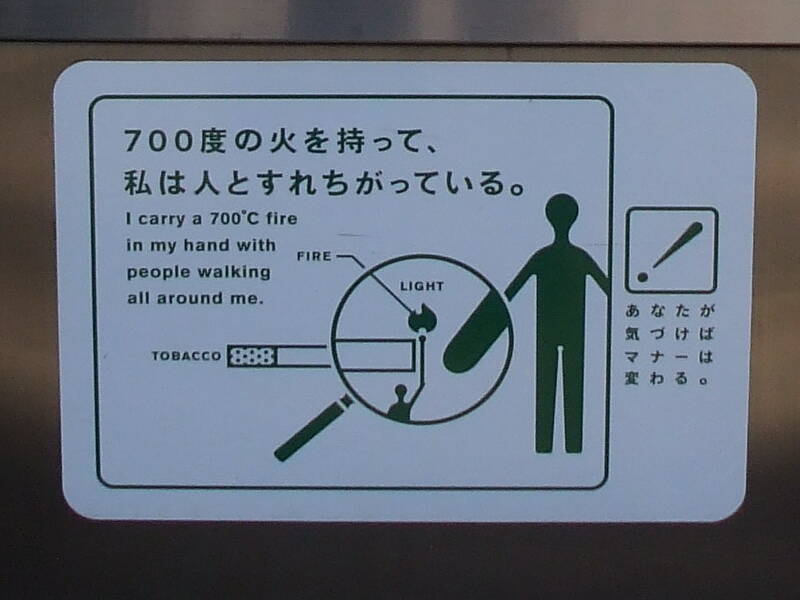
Cigarettes are Available
VisitingKamakura
Of course it's still easy to buy cigarettes, many shops carry them and there are vending machines like these at the train station in Kamakua.

At first it looks as if there are duplicates, many choices that are the same product from the same company.
But looking closer, the choices differ. They have different levels of nicotine, from a maximum of 12 mg down to 1 mg. This lets people try to wean themselves off nicotine, one of the most addictive drugs.

12 mg of nicotine per cigarette seems to be the highest concentration available in Japan. Meanwhile, in the U.S., where the nicotine content has increased over time, 12 mg is about the average and it goes as high as about 28 mg. The low end is 6 mg in the U.S., six times what's available from these machines.

The above are machines in Kamakura, below are two in Nagasaki. The prices will be the same, as they're set nation-wide by the manufacturer and approved by the Ministry of Finance.
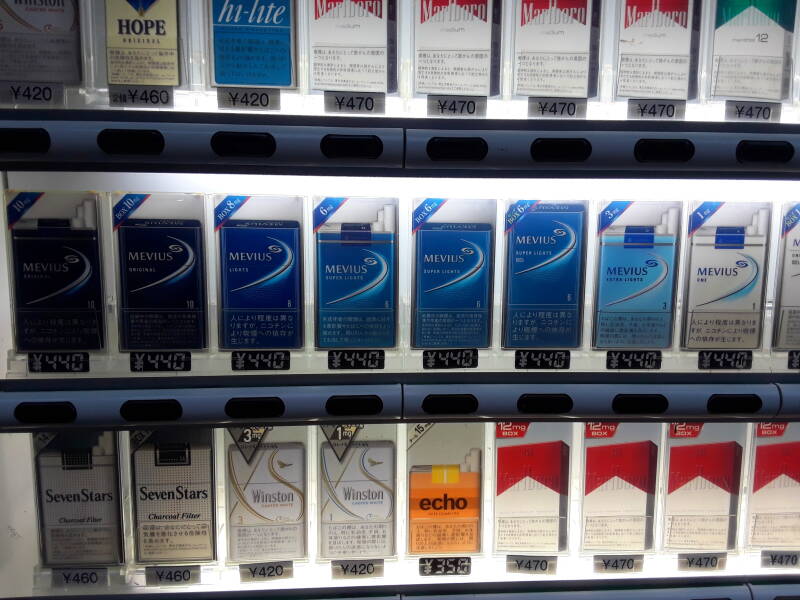

Anti-Smoking Pressure
Here's another example of the quirky Japan Tobacco signs meant as a "nudge", a relatively gentle influence on behavior intended for the good of the public (while also making sure their business isn't hurt).
VisitingFukuoka
The Kushida shrine was established in 757 CE in Fukuoka. It hosts the annual Hakata Gion Yamakasa, the city's largest festival.
Buddhism andShintō
It is said to enshrine three Shintō kami or spirits — Ohata, Amaterasu, and Susanoo.
It's a crucial site in the history and culture of the city. They don't want smokers trashing the place.
Approaching the shrine you come to the ablutions fountain where you clean yourself before entering. As this is a Shintō shrine, the water reservoir is the chōzubachi, under a shelter or chōzuya, or temizuya, where you do the purification rite or temizu. At a Buddhist temple everything would be the same, except with different words.
The huge difference is that in the U.S., the trough around the fountain would be filled with cigarette butts. Not here.
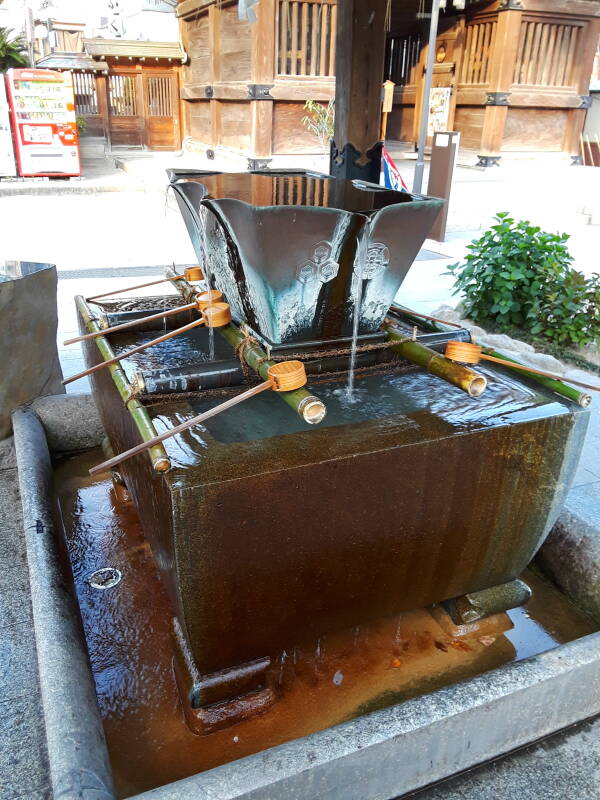
Nearby is a shelter with a cigarette vending machine and a secure fire-proof waste receptacle. This is the local smoking area.
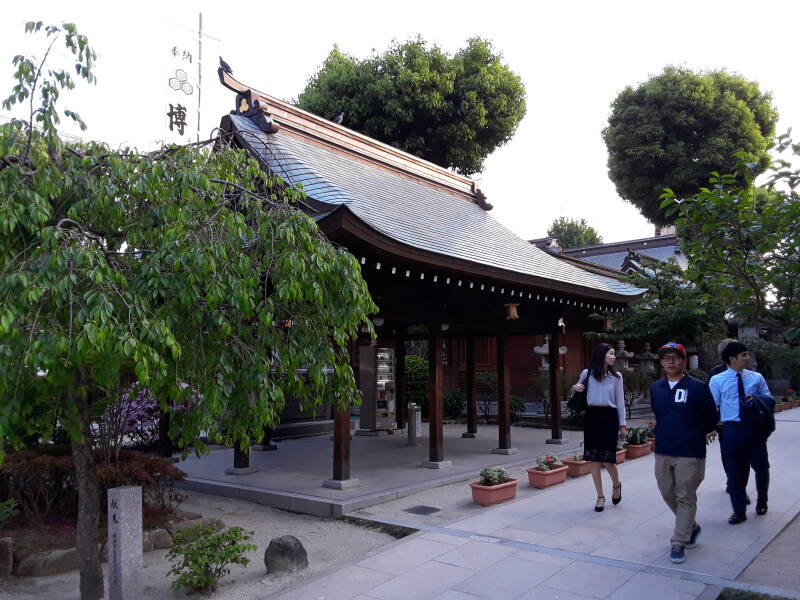
The waste receptacle bears one of the Japan Tobacco signs:
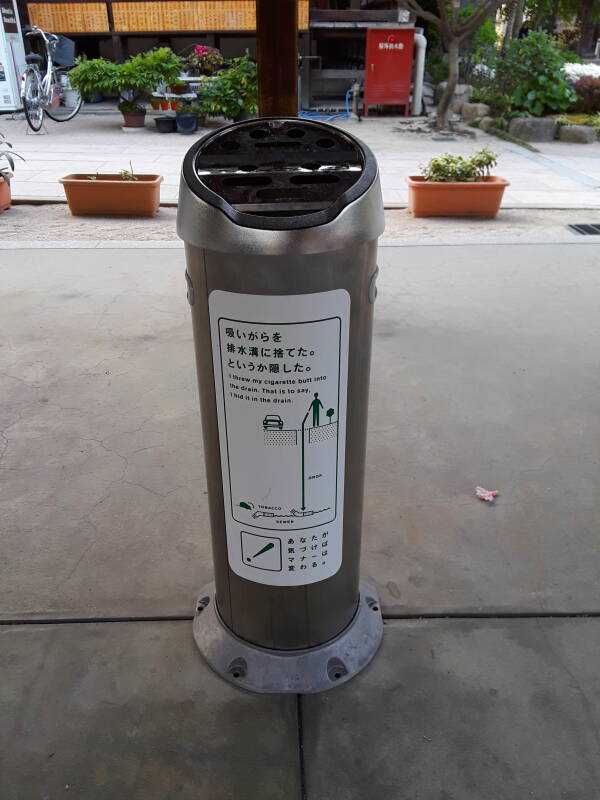
Properly cleansed, we can enter through the main gate.
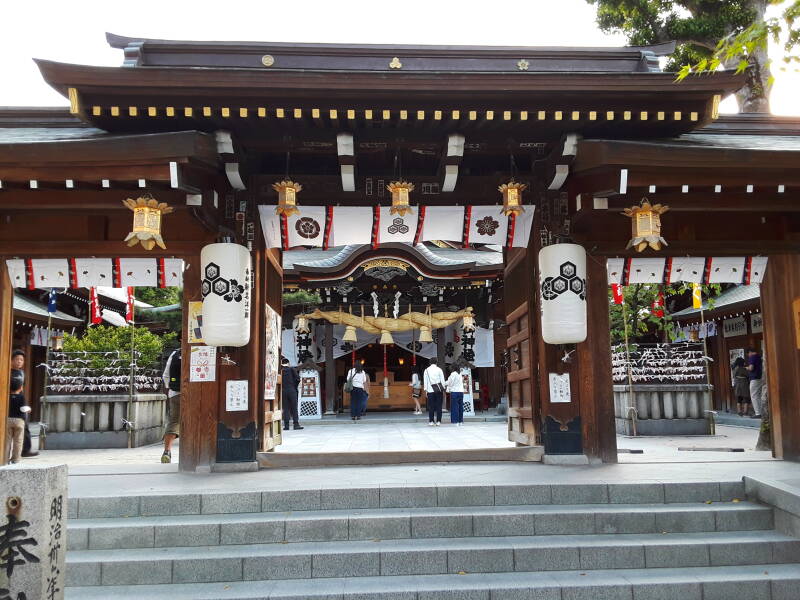
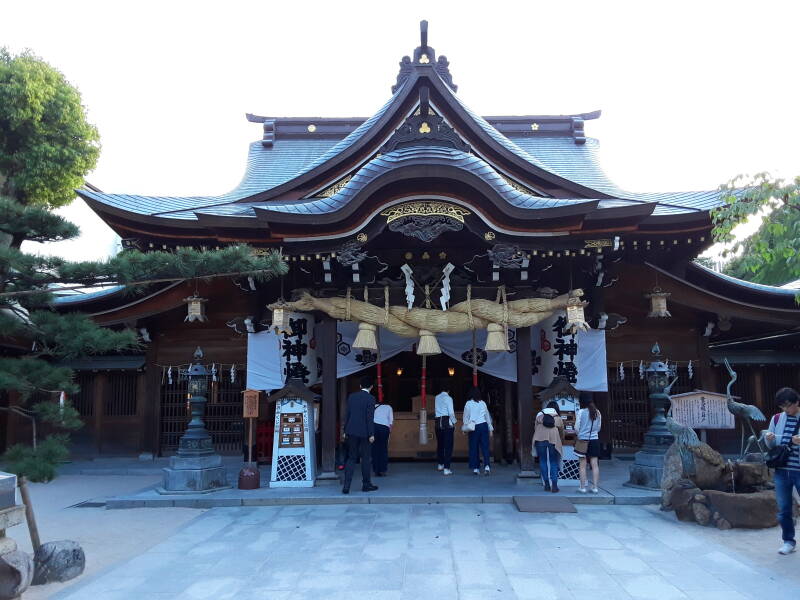
The large shimenawa or twisted rope is made from rice straw, and the white shide or zigzag streamer is made from paper. These can represent the invisible enshrined kami.
They're also highly flammable. This is nowhere to be waving lighted cigarettes. Which, as Japan Tobacco has told us, burn at 700 °C. Ray Bradbury has told us that paper ignites at 451 °F, which is just 232.8 °C. So, cigarettes are dangerous pretty much everywhere. Especially so around paper streamers and rice straw ropes.
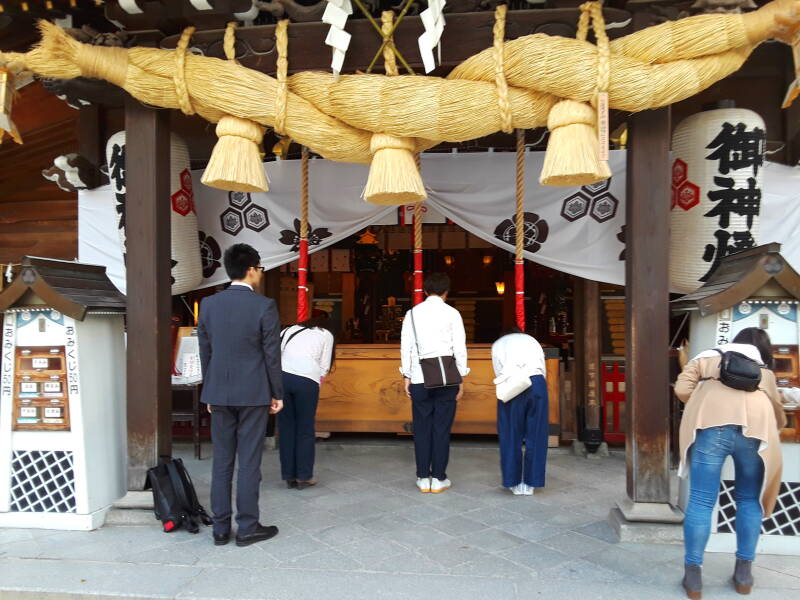

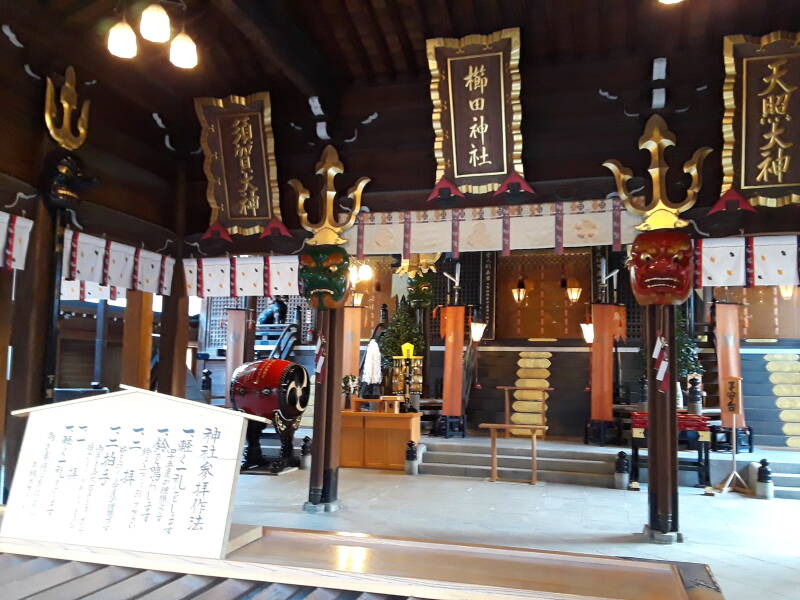
The above is specific to travel logistics. Maybe you're looking for information on specific places in Japan.




































